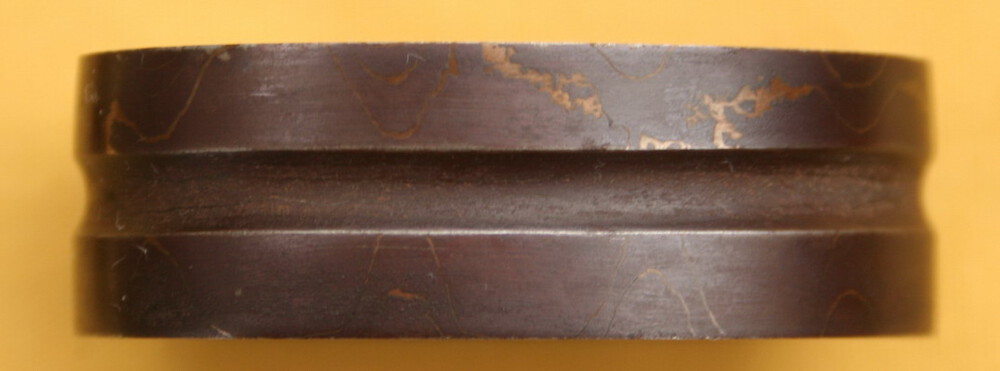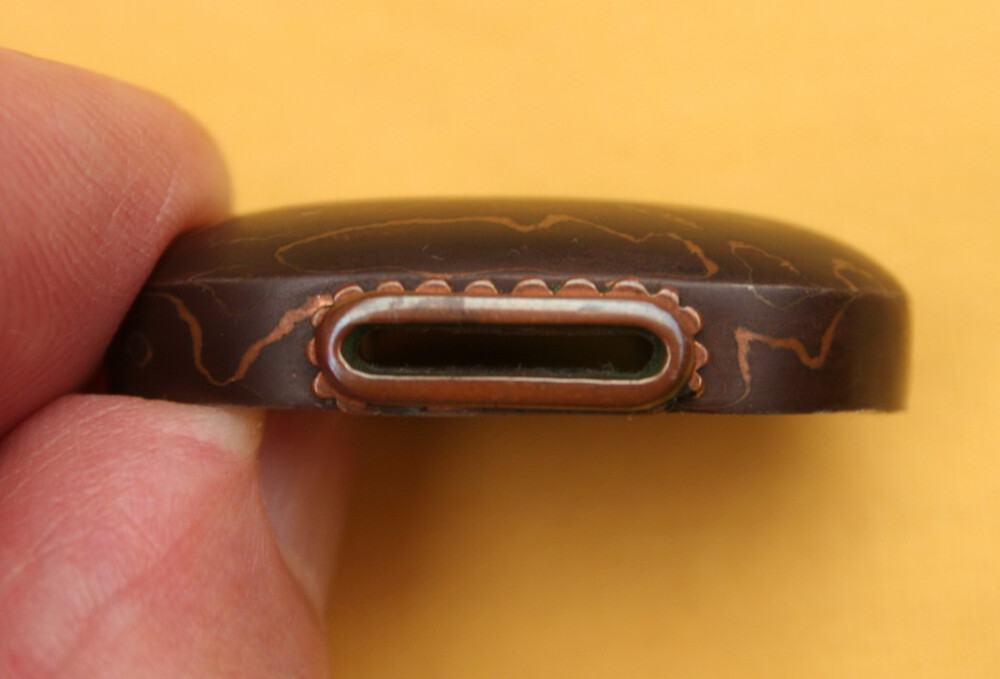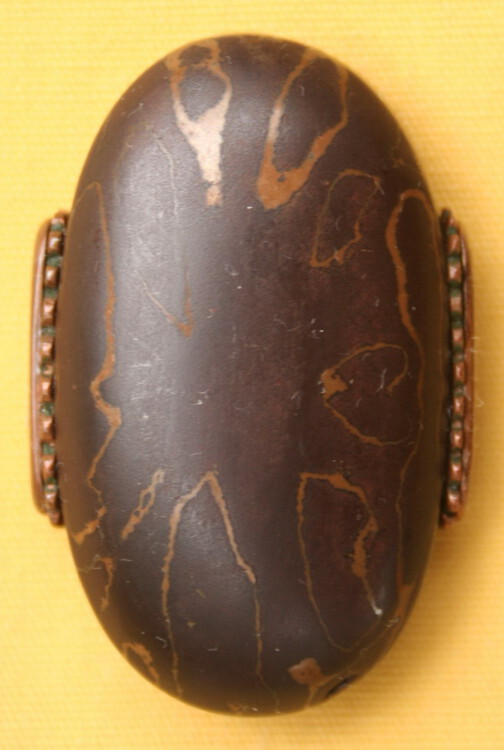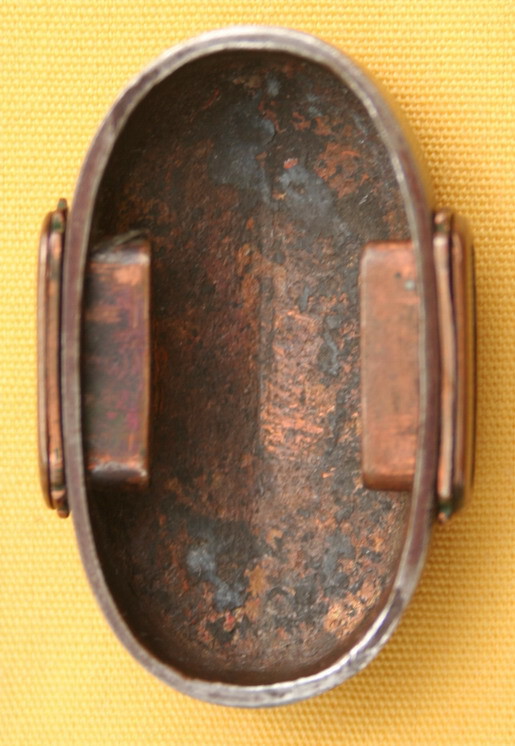-
Posts
2,814 -
Joined
-
Last visited
-
Days Won
27
Content Type
Profiles
Forums
Events
Store
Downloads
Gallery
Everything posted by Bazza
-
Images in the first email appear to show the hamon running off the edge of the blade. If so, a "dead" sword. The ha also appears to curve in from the hamachi indicating either a tired old blade or one that has sustained severe enough damage (chipping) that the mihaba has been reduced. The tsuba and koiguchi are en suite and look interesting, but I'll leave the tosogu boys to comment on that. Barry Thomas.
-
A friend of mine here in Victoria, Australia, is a custom knife maker. He has some very nice small knives with brilliant nioi suguba hamon. He once showed me a fuchigashira. I examined them for a while and asked him "Did you take these off a sword?". A big grin spread across his face - he had made them!! He had never made fuchigashira before and these are his one-off work and I present them for your interest. Oh, he also made the hitodome. Best regards, Barry Thomas.
-
Lovely, lovely work Ford. Speaking of textures I've been beguiled by the Nara (?) technique of wind 'shadowing' across smooth water and would like to know more about this - if there is anything more to be known. Could we also see a pic of the mei you carved in a full-on picture, please?? I'm reminded of a fuchigashira a knife-making friend created as an "exercise" and I'll put them up in Tosogu. Best regards, Barry Thomas.
-
HUH???!!! Stephen, Oyabun san, the first person to welcome me to this board (if my increasingly Swiss cheese brain remembers correctly) please halt, desist and stop any action you might be contemplating. Have a rest if you wish, but do stay. I echo Curran's words. I'm an editor of an antique arms magazine and had a blazing row in Committee one night with the president, threw my hat on the table, said "I don't need this", gave them my resignation and stormed out. Guess who is still editor... When I had cooled down (it took a few weeks, actually) I thought of all the fantastic people I know in antique arms collecting and decided that they shouldn't suffer for one man's unfortunate choice of words on one occasion. Now of course I have no idea what this is all about, but if you are thinking of leaving I add my voice to the clamour for you to stay - I for one would miss you too much. Bestests, BaZZa.
-
I feel this statement needs to be qualified somewhat ...if it looks like a repair then it may merely have been done by an inept artisan...if it was done by a suitably skilled artisan, on the other hand, you wouldn't necessarily notice a repair...it may actually be invisible to you as such. I've seen enough top class urushi restoration to know this to be true. Much of it by Mr Tomizo Saratani, Gunter Heckmann's own teacher. regards, ford Ford, Yes indeed, I meant to say AMATEUR repair. Thanks for the correction. Regards Barry Thomas.
-
A long time ago I sent a tanto saya to Japan for lacquer repair. It was a "centipede" style with"waves" about two inches (~5cm) long. There was a patch of damaged lacquer about the size of one's little fingernail. The lacquer was brown with some slightly raised pattern. When it came back from Japan the repair was to me a disaster. Not only was the damaged section not to be seen, but an area some 3 inches overall (~7.5cm) was smeared all-over with some "bog" that bore no resemblance in style or colour with the original lacquer. It was the most insensitive, philistinic repair I could have imagined. I was gobsmacked and truly felt I could have done a more sympathetic job myself. On reflection, it would have been better left alone. The first point I want to make is that mentioned in a post above - a repair always looks like - A REPAIR... I have never repeated this mistake. The second point I want to make (also made above) is that repairing lacquer is the most difficult thing you can imagine. It is not "paint" like oil paint, nor like repairing auto lacquer. For good quality Japanese lacquer (urushi) the process is EXTREMELY COMPLICATED, TIME CONSUMING and TEDIOUS if it is to be successful. This is NOT something to be done by a first time amateur. Indeed, a poor repair can reduce the value of an antique scabbard originally made with high quality lacquer as it sticks out like a sore thumb. I think even the cashew lacquer work that Guido and Ford talk about would take a considerable time to develop the skill required for the results Guido posted (lovely work, agreed). I believe that in Japan to become a lacquer artisan takes even longer than apprenticeships in sword forging or polishing. This should give a better idea of the magnitude of the undertaking. Jock, if you are determined to have your lacquer repaired could I suggest you have an experienced person to look at it first and see if it is at all worth repairing in the first place. Much lacquer on sword scabbards is shoddy and poor quality and one may be better completely re-doing the saya. I hasten to say take caution here and tread lightly, for lacquer is a "high art" - you wouldn't take an Old Master painting to a house painter to restore. That is an analogy true to the specialist nature of lacquer. A person to approach for this in the USA is Dr Thomas L. Buck - his website in general is an excellent read - http://www.tsukamaki.net/ I have loved lacquer for 40 years and have always wanted to "do" it. Now retired, I'm approaching this with caution. For anyone wanting to "bone up" on lacquer the urushi section of Ford Hallam's 'followtheironbrush' forum is a good start - http://www.followingtheironbrush.org/vi ... 8f639639a5. The next would be to buy the book "Urushi" from Gunther Heckmann of NIHON ART PUBLISHERS - http://www.nihonart.de/en/index.php for the website and http://www.nihonart.de/en/produkte_seturushi.php for the book itself. It is very, very comprehensive and a tribute to Gunther Heckmann's years of study under a Master in Japan and his own skills at lacquer conservation. I have only just begun to read my copy. Finally, in this long-winded treatise, just trawl google with keywords 'urushi' ; 'Japanese lacquer' and as many urushi related keywords you can think of. Best regards, Barry Thomas.
-
I heartily endorse Ian's advice. I have seen a magnificent Shinshinto katana in original koshirae. It is signed MINAMOTO HIDE (also read TERU)TSUGU SESSHU OMIYA HACHIMAN SANROKU-ni OITE KORE-o TSUKURU. It can be seen on the Board here, the first image and description: viewtopic.php?f=9&t=4666&st=0&sk=t&sd=a&hilit=sydney+display&start=45. The koshirae is original to the blade. I've also seen a Shinshinto katana made in Sendai with extensive inscription in Sosho and dated 1862 with an unusual handachi koshirae with gold lacquered same. Elsewhere in Australia is a Korekazu VII katana with original koshirae, although this one would run to much more than 10,000 pounds... So yes, there is much fertile ground in Shinshinto. Do please let us know what you eventually buy. Best regards, Barry Thomas. (Melbourne, Australia)
-
100% agree with you! I never buy signed blades except with showato, with showato you can be pretty sure they are never gimei! :D Dear Bruno, I resist buying into this at length, but I do want to say in short that with this view you are missing out on the greatest challenge of all - finding a quality blade that is genuine and a great work, be it signed or not. My 45 years in collecting have been marked with some lovely finds and also some real dogs in both signed and unsigned blades. The exercise is really to find quality by winnowing the wheat from the chaff in the stream of swords (aka tarts...) that pass by. It is here that an essay of finds could start... Best regards, Barry Thomas.
-
George et al, Here is another source that might help the discussion: http://www.nihontocraft.com/Izumi_no_Ka ... a_mei.html Best regards, Barry Thomas.
-
Jimmy, Do check out Danny Massey's excellent website for Mishina: http://www.nihontocraft.com/Mishina.html and for Mihara: http://www.nihontocraft.com/Mihara_Nihonto.html Best regards, Barry Thomas (Melbourne, Australia)
-
Stephen, Gavin Hougham's website offers a list of places to see Nihonto in Japan. His website in general is http://www.geocities.com/Tokyo/Palace/1135/ and the link to the sword places to visit is http://www.geocities.com/Tokyo/Palace/1135/sights.html. You could also check out Richard Stein's website at http://home.earthlink.net/~steinrl/nihonto.htm, and in particular his links, which have numerous Japanese websites http://home.earthlink.net/~steinrl/sites.htm and http://home.earthlink.net/~steinrl/sites2.htm. Do check these fairly soon as Richard has a monthly bandwidth quota that may not last the month. I hope you will give us a report when you return. Best regards, Barry Thomas Melbourne Australia
-
G'day Swordy Comrades, I've stumbled upon this article in the "Gold Bulletin" on shakudo that may be of interest. http://www.goldbulletin.org/assets/file ... i_4_16.pdf Best regards, Barry Thomas.
-
> Yes, there is a seki stamp on the nakago. I almost didn't see it. It's basically non-traditionally made sword?? Yep. Regards, Barry Thomas.
-
Dear All,, I am a paid up member of a military museum and I have just received their Annual Report. It will become clear why this Museum should remain anonymous. This museum has a man who, as part of his Edged Weapons charter, "restores" swords, all kinds of swords, and brings in considerable $$$$$ (so noted in the Annual Report) from the public to the Museum for his sword restoration services outside the Museum's Charter. Unfortunately, he also "restores" Nihonto. It is abundantly clear to me that this man has no idea what he is doing, no idea at all. What is more galling to me is that I am well enough known to the Manager and others as a knowledgeable person with Nihonto, yet despite this it is also well known that the "restorer" in question is known to be a person of inadequate expertise in the matter of Nihonto. I put continued acceptance of this man in his role down to the complete lack of knowledge on the part of the Manager and the Board. Of course, I'm working to change this without treading on sensitivities or crumpling the personal image of otherwise well-intentioned and good people. It is not this I want to dwell on, but rather to ask the following question: I have two videos/DVDs on sword forging - (1) "The Secret World of the Japanese Swordsmith" from Fred Chang at swordsmithsecret@hotmail.com featuring Yoshindo Yoshihara, and (2) "Takumi" ("Artisan"), featuring Ono Yoshimitsu, a video courtesy of Paul Martin http://www.users.on.net/~coxm/3.%20articles.html. I show these two videos to whomsoever I can wherever I can to advance knowledge and appreciation of the Japanese sword as a Fine Art. Can anyone tell me of similar video/DVD material on polishing as an art?????? Hopefully, Barry Thomas.
-
It looks like DOI SHINRYO to me - a Hirado (Hizen) smith. Barry Thomas.
-
Unquestionably a gunto. Koshirae is a rebuild of some sort. Barry Thomas.
-
Looks like "Noshu SEKI JU Sukegawa Sadamitsu". It would appear to be an arsenal production - is there a Seki stamp to the top rhs of the nakago???? Regards, Barry Thomas.
-
HOORAY - AT LAST. I agree with Ford (as the apprentice to the Wizard might have agreed!!!). The mei has been analysed to death (correctly so) but Ford is the first (I think) to comment on the quality of the work itself. I think these pieces are Meiji at best and copies alluding to earlier work. To me they are uninspiring and dull. The colour of the metal is not that of quality. Also, the tagane (chiselling) of the mei lacks the control of a master hand - compare with Goto Ichijo, for example. It is wonky and all over the place. Unquestionably post-Edo and 'glitzy gimei' IMHO. Best regards, Barry Thomas (Who opens his mouth so that others may put their feet in...)
-

Old Documents on Google Books
Bazza replied to Ray Singer's topic in General Nihonto Related Discussion
And have a look at this search result for Brinkley on NMB: search.php?keywords=brinkley&terms=all&author=&sc=1&sf=all&sk=t&sd=d&sr=posts&st=0&ch=300&t=0&submit=Search Regards, Barry Thomas. -
Yes... Interesting thread as I've just seen a wakizashi with the hi painted a cream colour. I say "painted" because I have never seen any colour other than red. Any one else seen cream????? I think it's a gaijin amateur's work. Best regards, Barry Thomas.
-
A short time ago I reported the Irish police as having seized 7,000 swords. I have just found this discussion: http://nihontoclub.com/news/samurai-swo ... in-ireland The text accompanying the link (part of a discussion group) is below my sign off. Regards, Barry Thomas. ------------------------------- Talks about potential sword ban started in December 2007 after another high profile attack involving a 'samurai sword'. It is known that Department of Justice had been in contact with local martial arts organisations (Iaido Association of Ireland is particular) is order to avoid unnecessary restrictions for martial arts practitioners and authentic sword collectors. In the light of recent global trends to regulate possession and transportation of 'samurai' swords (which sometimes comes in quite narrow-minded forms) the new Irish legislation appears to be reasonable, especially taking into account the (more than modest) size of the local sword scene. Mirroring the UK sword ban which was introduced in April 2008 as one of the questionable measures to fight 'knife crime', authentic hand-made Japanese swords (Nihonto) are exempt (however I couldn't yet find any reference to whether sports equipment such as iaito and shinken is to be banned or not). The real concern is the practical side of the legislation and the way it's going to be implemented. There's been numerous occasions in UK since introduction of the sword ban when law-abiding collectors had trouble importing antique swords. It's perfectly understandable due to the fact that in order for Customs to make sure that it's legal to import a sword, some sort of certificate required proving its age and provenance. And the most common cert of this kind (if any) is the NBTHK paper hand-written in Japanese. No wonder Customs officers, sorting office workers and law enforcement authorities would not be able to take it as a supportive documentation without difficult (and costly) translation.And this is the neigbouring UK which is much more accustomed to importing/exporting Japanese collectible weapons than Irish. How many Customs officers and An Post employees were instructed about differences between replica and authentic Japanese swords or even have seen ones? Will they be collector-friendly or take an eBay approach and stop any import of 'illegal samurai-like swords' unless (with immense trouble) proven otherwise? If temporarily or permanently seized, will real Nihonto be given a proper care? There is no doubt that circulation of cheap and dangerous replica had to be stopped, even with the level or crime involving samurai swords being ridiculously low in comparison to the usage of widely available home utensils.But will the fair treatment of martial arts practitioners and sword collectors be guaranteed? Time will tell.
-
Dear All, I can imagine Nihonto related activities might have taken a temporary back set in the hometown of our esteemed Moderator... http://news.ninemsn.com.au/glance/92869 ... mpy-record Best regards, Barry Thomas.
-
Dear All, A friend sent me the following email information, which I feel bound to pass on without comment for general interest and information: ------------------------------ I came across this fellow on ebay today offering his services as Sword Polisher . The Item Number is 160374890927. ------------------------------- There are 12 photos of various swords in polish. The "auction" for a madoaki (window) ends in about 12 hours. If anyone who reads this has missed the auction and the details I have preserved the images and description. Please PM me if anyone wants this information. Best regards, Barry Thomas.
-

Gendaito gimei in general
Bazza replied to Aloof Pegasus's topic in General Nihonto Related Discussion
G'day All, In my early days of collecting it was very exciting to (a) find a sword and buy it, (b) translate the mei all by oneself and © find the smith was a pre-1868 man in Hawley's books, subsequently realising in some cases that it was a Showato in disguise. The first one such was a Mondo no Sho Masakiyo with aoi mon. However, the blade looked "funny". I eventually concluded it was a Showato (not a Gendaito) and passed it on. I also found another sword with a Shinto maker "in the books" that was also a Showato. Then there was a sword with a mei to a Koto Mino Kanekado that the owner had allegedly been offered a car for!!! Another obvious Showato. Friends have seen other swords of this kind. With a reasonable number of such found in our small part of the world my conclusion at that time was that these swords were indeed gimei intended to deceive. I hadn't thought that they might be regarded as "patriotic" with everyone in on the act, so I guess the jury is still out on the question??? Regards, Barry Thomas.





